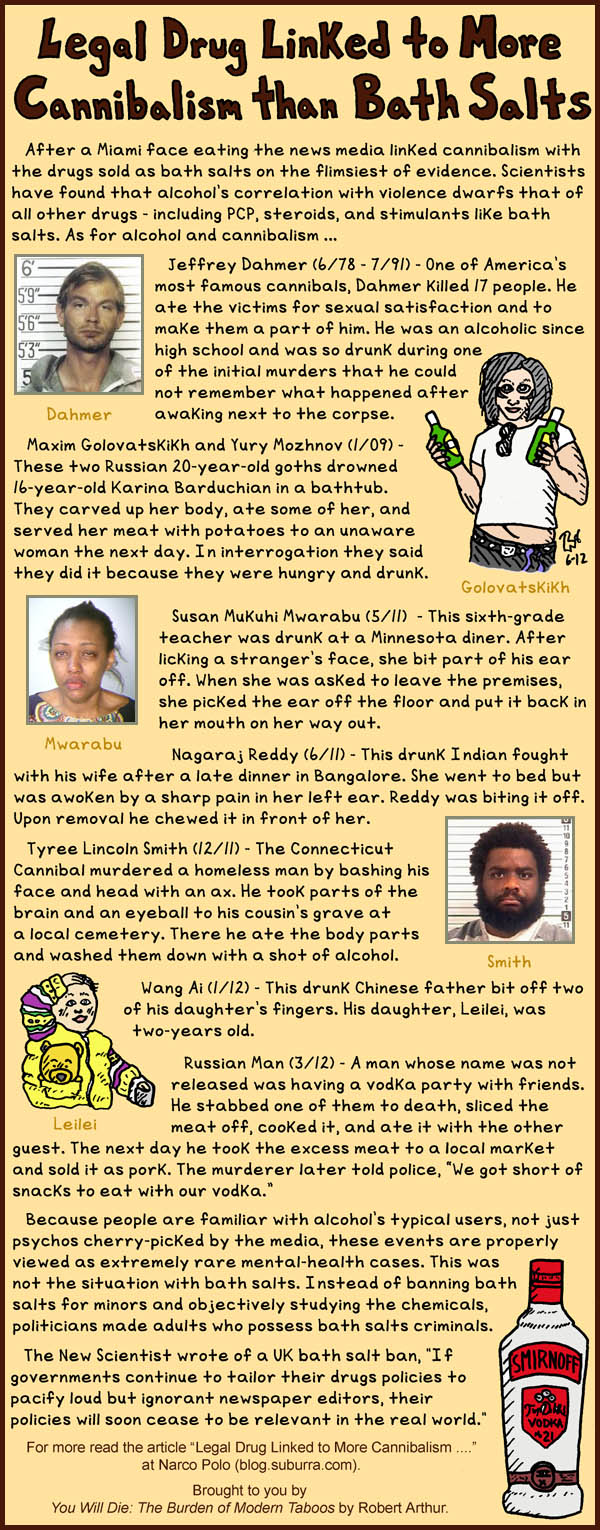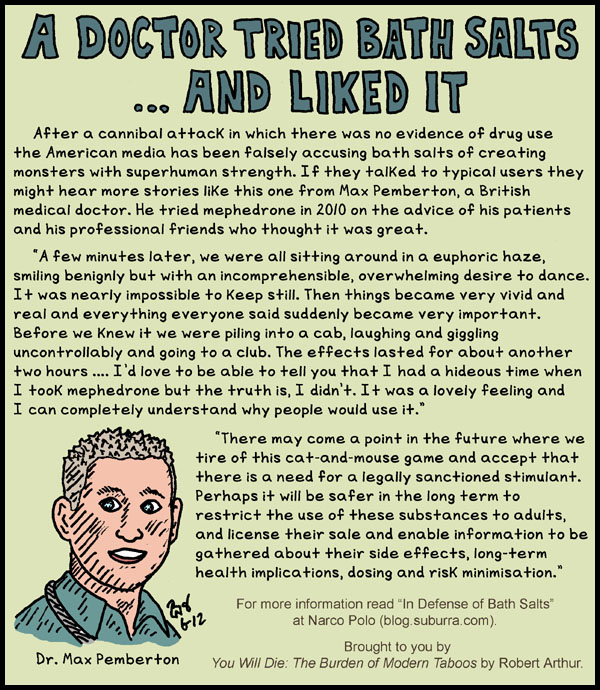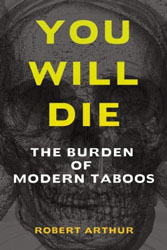Posted: October 11th, 2012 | Filed under: civil liberties, drugs, marijuana | Comments Off on How to Write About Your Crimes on the Web

In America, it is not illegal to write about your past crimes, and the following is a guide to doing it online. I am an attorney who has practiced criminal defense law, however, this article merely provides general legal information—not legal advice.
Any defense attorney will tell you that it is almost never prudent to make statements about your past crimes. This is particularly true online as it creates evidence, often permanent, that can be used in your prosecution. Unless you are masking your identity with software like Tor, every web site that you visit can record your computer’s Internet Protocol (IP) address. Without masking, this IP address is also delivered with every e-mail you send.
Nevertheless, even if the only precaution you take is to use a pseudonym it is highly unlikely you will be tracked down by law enforcement if you do it in a global forum and only talk about low-level crimes like sex work or drug use. It is not because the authorities cannot find you, but because it is not worth their time. Even the simple act of filing a warrant to discover an IP address is usually not worthwhile for multiple reasons:
- They do not know if you are lying.
- They would have to prove that it was you that used your computer and your pseudonym.
- They would have to have some evidence in addition to the internet admission.
- They often do not know if the crime occurred in their jurisdiction.
- They often do not know if the crime occurred outside of the statute of limitations.
There are three things you can do to increase the odds you will not be pursued. The most obvious is to hide your identity and any clues to your identity. Talking about a crime on a social network like Facebook, even with an alias, is risky as profiles provide other identifying information.
In forums that discuss drug use the acronym SWIM is often used instead of “I.” SWIM stands for “someone who isn’t me.” Using SWIM is better than using a first-person narrative but more creative obfuscation would be better. For example, saying a friend did the described activity.
Second, do not reveal the location of the crime. Law enforcement is bound by its jurisdiction. Police are significantly less likely to pursue a low-level crime if they are unsure if it occurred in their jurisdiction. For example, Philadelphia police are not going to waste time investigating something that probably occurred in another municipality or another state. For this reason, writing about crimes in a local forum, like the Littlestown Crocheting Message Board, is not wise.
Federal authorities have broader jurisdiction but rarely pursue low-level crimes, and they would almost never waste resources investigating a low-level crime that may have occurred abroad.
Third, do not disclose when the crime happened. Most crimes have a time limit on how long they are allowed to be prosecuted. These limits are called statutes of limitations. Law enforcement is unlikely to investigate low-level crimes that may no longer be open to prosecution.
Writing about your crimes online is rarely advisable, however, writing about low-level crimes in global forums has scant chance of spurring investigation if you use these precautions.
Links
- Criminal statute of limitations laws by state: LINK
- Facebook’s procedures for law enforcement seeking a user’s data: LINK
- Rocco Parscandola, “NYPD Forms New Social Media Unit to Mine Facebook and Twitter for Mayhem,” NYDailyNews.com, 10 Aug. 2011. LINK
- Tor’s website: LINK
Bonus
The following tweets by Mary Wanna? are examples of oversharing online. Follow Marry Wanna? on Twitter at @the_high_life.


Posted: June 19th, 2012 | Filed under: alcohol, bath salts, drugs, media bias | 8 Comments »

(For more information on bath salts read “Doctor Tried Bath Salts and Liked It: In Defense of Bath Salts.” For an alternate theory of the Causeway Cannibal read “Did Bible Study and Anti-Drug Vow Cause Miami Cannibal Attack?”)
After a face eating the objective news media linked cannibalism with the drugs sold as bath salts on the flimsiest of evidence:
Rudy Eugene (5/26/12) – In the face-eating case, the media continues to link the Miami Causeway Cannibal to bath salts based on the Miami police union chief’s spurious speculation even though initial toxicology reports found no evidence of bath salts in his system.*
Brandon De Leon (6/2/12) – After being arrested for disorderly conduct a homeless Miami man tried to bite an officer and threatened to eat one. A toxicology test found that he had marijuana and Xanax in his system. He was also extremely intoxicated with a blood alcohol content over three times the legal limit for driving (.29). No bath salt chemicals were found by the blood test but news reports say it was “later discovered” that De Leon used the bath salt, Cloud 9.
Carl Jacquneaux (6/5/12) – A Louisiana man, Carl Jacquneaux, bit his neighbor’s face in a fight. The only evidence of a bath salts connection was the victim’s friend said that Jacquneaux used bath salts.
The idiocy of blaming bath salts for violent gore is obvious to the average person who has used these substances. A bath salt, mephedrone, has been one of the top club drugs in the UK for years and has never precipitated cannibalism. (4) Scientists have found that alcohol’s correlation with violence dwarfs that of all other drugs – including PCP, steroids, and stimulants like bath salts. (3) Compare the following acts of cannibalism involving alcohol with the bath salts’ incidents above:
Jeffrey Dahmer (6/78 – 7/91) – One of America’s most famous cannibals, Dahmer killed 17 victims over a 14-year period. He spoke of eating his victims with Dateline NBC in 1994, “It made me feel like they were a permanent part of me …. and it gave me a sexual satisfaction to do that.” (See 20-second clip here.) Dahmer was an alcoholic since high school. He was so drunk during the 1989 murder that launched his spree of savagery that after awaking next to the corpse he could not remember what had happened.
Maxim Golovatskikh and Yury Mozhnov (1/09) – These two Russian 20-year-old goths drowned 16-year-old Karina Barduchian in a St. Petersburg bathtub. They carved up her body, ate some of her, and served her meat with potatoes to an unaware woman the next day. The victim was in love with Golovatskikh, a minor pop star. In interrogation they said they did it because they were hungry and drunk.
Susan Mukuhi Mwarabu (5/11) – This sixth-grade teacher was drunk at a St. Paul, Minnesota diner. After licking a stranger’s face, she bit part of his ear off. When she was asked to leave the premises she picked the ear off the floor and put it back in her mouth on her way out.
Nagaraj Reddy (6/11) – This drunk Indian fought with his wife after a late dinner in Bangalore. She went to bed but was awoken by a sharp pain in her left ear. Her husband was biting it off. She told the police, “He chewed it in front of me. It was disgusting.” (5)
Tyree Lincoln Smith (12/11) – The Connecticut Cannibal murdered a homeless man by bashing his face and head with an ax. He took parts of the brain and an eyeball to his cousin’s grave at a local cemetery. There he ate the body parts and washed them down with a shot of alcohol. He told another cousin that, “he had gotten a rare steak at a restaurant in Florida and when he had tasted the blood it had given him a sexual sensation.” (1) He said the victim’s eyeball tasted like oyster.
Wang Ai (1/12) – This drunk Chinese father bit off two of his daughter’s fingers in China’s Guizhou province. His daughter, Leilei, was two-years old.
Russian Man (3/12) – A man whose name was not released was having a vodka party with friends. He stabbed one of them to death, sliced the meat off, cooked it, and ate it with the other guest. The next day he took the excess meat to a local market and sold it as pork. One of the three purchasers thought the meat tasted strange and took it to experts. The murderer later told police, “We got short of snacks to eat with our vodka.” (2)
Because people are familiar with alcohol’s typical users, not just psychos cherry-picked by the media, the alcohol incidents are properly viewed as extremely rare mental-health cases. Due to yellow journalism responsible bath salts users are invisible. Instead of banning bath salts for minors and objectively studying the chemicals, politicians have responded to the distorted media attention by declaring all adults who possess them criminals.
* Addendum (June 28, 2012) – The full toxicology report of Rudy Eugene released on June 27, 2012 reported that the only drug found in his body was marijuana. The common chemicals in drugs sold as bath salts were absent. LINK
Addendum (July 2, 2012) – On June 26, 2012, a bus driver identified as “Dong” drank heavily at lunch in Wenzhou, China. Whereas his drinking buddies merely passed out, Dong ran into traffic and blocked a woman’s car. He climbed onto the hood and began smashing her windshield. When she exited the vehicle to escape, Dong tackled her and began eating her face. LINK
Sources
1. Martin Barillas, “‘Connecticut Cannibal’ Held on $1 Million Bond,” EnergyPublisher.com, 1 Feb. 2012. LINK
2. Matt Blake, “Russian Man Kills and Eats Drinking Partner ….,” DailyMail.co.uk, 26 Mar. 2012. LINK
3. Martin Brecher, et al., “Phencyclidine and Violence,” J. Clin. Psychopharmacol., Dec. 1988.
4. Jamie Doward, “Mephedrone More Popular Since Being Banned,” Guardian.co.uk, 10 Mar. 2012. LINK
5. “Husband Bites Wife’s Ear in Drunken Rage,” Siasat.com, 4 July 2011. LINK
6. “Politics of Facebook,” New Scientist, 24 Apr. 2010.
Posted: June 8th, 2012 | Filed under: bath salts, drugs, legalization, media bias | 11 Comments »

On May 26, 2012, a naked Rudy Eugene ate the face of Ronald Poppo by a Miami causeway. That evening CBS Miami featured the following interchange between news anchor Cynthia Demos and reporter Tiffani Helberg:
Cynthia Demos: The officer believes the man clearly, clearly was on some very, very powerful drugs.
Tiffani Helberg: That’s right, Cynthia. The Fraternal Order of Police president [Armando Aguilar] tells me this crop of LSD [bath salts] is a major threat to police officers as well as the rest of us. He says it turns normal people into monsters that possess this superhuman strength and no ability to feel pain. He believes that’s what was behind the incident that unfolded here …. (5)
The Truth
Everything Helberg said was false and there was no evidence Eugene was on drugs. However, based largely on Aguilar’s specious speculation the media released an avalanche of drug bashing on bath salts. Bath salts usually refer to synthetic versions of cathinone, the psychoactive chemical in the khat bush. Khat leaves have been consumed by Africans for over 700 years without being associated with bizarre behavior. They use it in the same cultural manner that Westerners use caffeine.
Cathinones are merely stimulants. When researchers go beyond colorful anecdotes and urban myths the evidence is scant that stimulants cause violence and they certainly do not cause superhuman strength or an inability to feel pain. (6) Extreme use of any stimulant – even caffeine – can cause temporary psychosis, and can trigger schizophrenia in those that are predisposed to it. (These effects are not limited to drugs. Extreme sleep deprivation can also cause temporary psychosis, and any highly stressful event can trigger schizophrenia in those that are predisposed.)
Psychosis and drug use are not statistically significant predictors of violence by themselves. It is only when both are combined with violent tendencies that it is problematic. (3,7) Violent people and those with severe mental health issues should avoid overusing stimulants, just like they should avoid overusing the drug whose correlation with violence dwarfs all others – alcohol. (2) (Read about “Legal Drug Linked to More Cannibalism than Bath Salts.”)
The Doctor Who Had Fun
Extreme behavior from using bath salts is rare and yet the media insists on presenting only the horror stories. They take sensational quotes from doctors and police whose sole exposure to cathinone users is from emergency rooms and crime scenes. If doctors and police only had exposure to drinkers in emergency rooms and crime scenes their view of alcohol would be just as distorted.* (For another reason for distortion see “The Banana Effect: How Drugs Get a Bad Rap from Their Users.”)
If the media bothered to quote typical cathinone users, the public would hear more stories like that of the British medical doctor, Max Pemberton. Pemberton had heard his patients rave about the drug mephedrone that they enjoyed taking on the weekends. (Mephedrone is one of the cathinones commonly sold as bath salts. It was sold in Britain not as a bath salt, but as a plant food, and acquired the street name meow-meow.) When he asked his friends about mephedrone – a lawyer, an architect, and two people in publishing – they all told him “how good it was.” Pemberton tried it with another doctor and some friends on a Saturday in March of 2010. This is how he described the experience:
A few minutes later, we were all sitting around in a euphoric haze, smiling benignly but with an incomprehensible, overwhelming desire to dance. It was nearly impossible to keep still. Then things became very vivid and real and everything everyone said suddenly became very important. Before we knew it we were piling into a cab, laughing and giggling uncontrollably and going to a club. The effects lasted for about another two hours …. I’d love to be able to tell you that I had a hideous time when I took mephedrone but the truth is, I didn’t. It was a lovely feeling and I can completely understand why people would use it. (8)
Ignorant Newspaper Editors
The British media sensationalized mephedrone in 2009 just as the American media is now. Yellow journalism resulted in stories about mephedrone deaths including Gabrielle Price, a 14-year-old girl. She was made the poster child of mephedrone evil even though a later investigation found that she died of pneumonia – not mephedrone. Of the 27 fatalities attributed to mephedrone by the screaming press, coroners eventually determined that only two could have been caused by mephedrone. (To read how drug deaths are often fabricated read, “Billy Mays’ Corpse Gets Trampled by Cocaine Hype.”) A headline grabber about a boy on mephedrone who ripped his scrotum off was also later debunked. (4)
Mephedrone was banned in the UK in April 2010. A member of the UK’s independent expert body that advises the government on drug-related issues quit because of pressure by media and politicians to make a quick decision on banning mephedrone without examining the evidence. (1) The New Scientist wrote of the ban:
If governments continue to tailor their drugs policies to pacify loud but ignorant newspaper editors, their policies will soon cease to be relevant in the real world. If they want their drugs policy to work, it must be thoughtful, rational and evidence-based, not a cynical, politically motivated stunt to pacify the editors of tabloid newspapers. (9)
(For an alternate theory of the Causeway Cannibal read “Did Bible Study and Anti-Drug Vow Cause Miami Cannibal Attack?”)
* This phenomenon is called the clinician’s error and is explained in more detail at Maia Szalavitz’s article at Time.com, “Why Drugs Are Getting a Bum Rap in the Miami Face-Eating Attack.”
Addendum (June 28, 2012) – The full toxicology report of Rudy Eugene released on June 27, 2012 reported that the only drug found in his body was marijuana. The common chemicals in drugs sold as bath salts were absent. LINK
Sources
1. “A Collapse in Integrity of Scientific Advice in the UK,” Lancet, 17 Apr. 2010. LINK
2. Martin Brecher, et al., “Phencyclidine and Violence,” J. Clin. Psychopharmacol., Dec. 1988.
3. Eric Elbogen & Sally Johnson, “Intricate Link Between Violence and Mental Disorder,” Arch. Gen. Psychiatry, Feb. 2009.
4. Nic Fleming, “Truth About Mephedrone,” New Scientist, 24 Apr. 2010.
5. Tiffani Helberg, “Miami Police Shoot, Kill Man Eating Another Man’s Face,” CBSLocal.com, 26 May 2012. LINK
6. Peter Hoaken & Sherry Stewart, “Drugs of Abuse and the Elicitation of Human Aggressive Behavior,” Addict. Behav., 2003, 28.
7. Rick Nauert, “Mental Illness Does Not Predict Violence,” PsychCentral.com, 26 Feb. 2009.
8. Max Pemberton, “I Took Mephedrone and I Liked It,” Telegraph.co.uk, 20 Mar. 2010. LINK
9. “Politics of Facebook,” New Scientist, 24 Apr. 2010.







